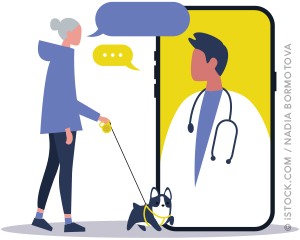
Fam Pract Manag. 2021;28(1):36
TRY THIS MENTAL STATUS EXAM FOR TELEHEALTH VISITS

Many of us are doing more telehealth visits during the COVID-19 pandemic. But when those visits call for a mental status exam, things can get tricky. The Mini-Mental State Examination, Montreal Cognitive Assessment, and St. Louis University Mental Status Exam all require reading and writing, which are difficult to do via telehealth.
Instead, I use an old but validated 10-question screen: the Short Portable Mental Status Questionnaire (SPMSQ). It includes 10 standard questions with no need for the patient to write or read, which makes it a very useful test in hospitals, in nursing homes, and via telephone or telehealth visits. The SPMSQ gives an overall score of 0–10, and I usually note the questions patients got right if they missed most of them, or the ones they missed if they got most right.
Documenting the patient's correct or incorrect answers can help indicate the complexity of the medical decision making or the extended time required for the visit, and support higher level coding.
For patients who do poorly on the SPMSQ, I usually estimate the Glasgow Coma Scale to get a quantitative estimate of their verbal and command-following abilities. If mood is a consideration, the Patient Health Questionnaire-2 is a quick screen that also produces a numerical score.
USE PERSONAL STORIES TO PREPARE PATIENTS FOR A COVID-19 VACCINE
Multiple COVID-19 vaccine manufacturers have now received, or will soon receive, Food and Drug Administration (FDA) emergency use authorization, fore-shadowing a potential path out of the pandemic. But polls have shown a significant percentage of Americans are hesitant to get a COVID-19 vaccine, which could delay or even prevent the United States from reaching immunization levels high enough to produce herd immunity. Trusted frontline health care workers, especially family physicians, can help lay the groundwork for greater vaccine acceptance. Physicians can educate patients about the rigorous testing the FDA requires before it approves vaccines, as well as the ongoing monitoring of adverse events that takes place after approval. But studies show that the most effective conversation physicians and other frontline workers can have with patients centers around their own decisions to vaccinate themselves and their family members. Health care workers are likely to have access to COVID-19 vaccines before the general public, due to their risk of exposure. Their personal anecdotes about getting the shot could be key to convincing more of their patients to do the same.
SEND ORDERS DIRECTLY TO PATIENTS' PREFERRED LABS OR IMAGING CENTERS
I have tried multiple ways to get patients to do their wellness labs and imaging before their annual physicals, including repeatedly educating them, handing them the orders, and other tactics. But I've found that the most effective way, by far, is to fax the orders to their preferred location instead of handing them the orders on the day of an office visit leading up to their physical.
With the EHR we have, I can fax orders to one of the facilities that patients have listed as a preferred location. Occasionally we have to send another fax to a different location, but at least there is follow up and the order is not just lost. I have seen higher compliance with routine labs and mammograms using this strategy because patients can't lose the orders and the labs and imaging centers follow-up with patients. We still sometimes have to call insurance to get authorization, especially for aortic ultrasounds and low-dose chest computed tomography scans, but overall this method has saved us time.
